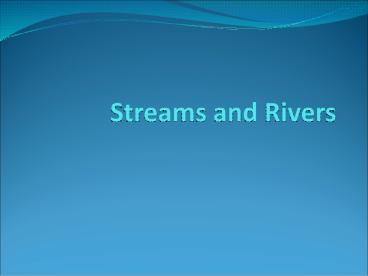Streams and Rivers - PowerPoint PPT Presentation
Title:
Streams and Rivers
Description:
Meander: to take a winding or indirect course Velocity: The distance that water travels in a given amount of time. A fast moving river can erode material more quickly ... – PowerPoint PPT presentation
Number of Views:811
Avg rating:3.0/5.0
Title: Streams and Rivers
1
Streams and Rivers
2
Streams and RiversDefinitions
- Tributary A stream that runs into another stream
or river - River System A river and all of its tributaries
- Watershed includes all of the land that drains
into the river
3
- Floodplain a nearly flat area along a stream or
river that is naturally subject to flooding.
4
Streams and Rivers Continued
- Oxbow Lake a C-shaped lake formed when a meander
is cut off from the main channel due to a lack of
energy and sedimentation
5
Rivers with Many Meanders
6
Formation of a Cutoff and Oxbow Lake
7
Deltas
- Delta a nearly flat plain of alluvial deposit
between diverging branches of the mouth of a
river, often triangular - Alluvial Deposit clay, silt or gravel deposited
where the stream slows down
8
(No Transcript)
9
Characteristics of Streams and Rivers
- Meander to take a winding or indirect course-gt
the bends in a river - Velocity The distance that water travels in a
given amount of time. - Gradient The slope of a stream
- (vertical distance/horizontal distance)
10
Characteristics Continued
- Discharge the volume of water that passes a
certain point in a given amount of time - Channel The path through which the water flows.
The size and shape effects the velocity
11
Diagram- will complete in class
12
Water Velocity
- Streams flow fastest in the middle, just below
the surface - The surface is slower because air provides a
little friction - The bottom is slower because the ground provides
friction - The sides are slower because the edge/shore
provides friction
13
(No Transcript)
14
From Above From WithinX marks the area
of highest velocity
15
ESRT (pg 6)
16
V-Shaped Valleys
- Most youthful river valleys are V-shaped
- V-shaped valleys are found in regions where there
is enough rain to erode the sides of the valley
17
The Yellowstone River Is an Example of a
V-Shaped Valley
18
Visualizations
- How Sediment is Transported
- Meanderings
19
(No Transcript)
20
- Erosion occurs on the outside of the bends where
the water is moving the fastest - Deposition occurs on the inside of the bends
where the water is moving the slowest
21
(No Transcript)
22
Video
- Watch Ms. Whittaker embarrass herself
- https//www.youtube.com/watch?vEwsxXs8vfhAindex
93listUUWC9pBDUrv8isgrWjCRs5Gg
23
Erosion by Wind
- When small, loose sediments like sand are
available, erosion by wind is possible - Arid regions are the most common places for wind
erosion to take place
24
- Ventifacts wedge-shaped rocks formed by wind
erosion, often pitted. The weaker, less resistant
materials are worn away the fastest
25
- Sand dunes are hills of sand deposited by wind
- Found wherever there are strong winds and loose
sand - Have long, gentle slope on windward side
- Have shorter, steep slope on leeward side
26
(No Transcript)
27
(No Transcript)































